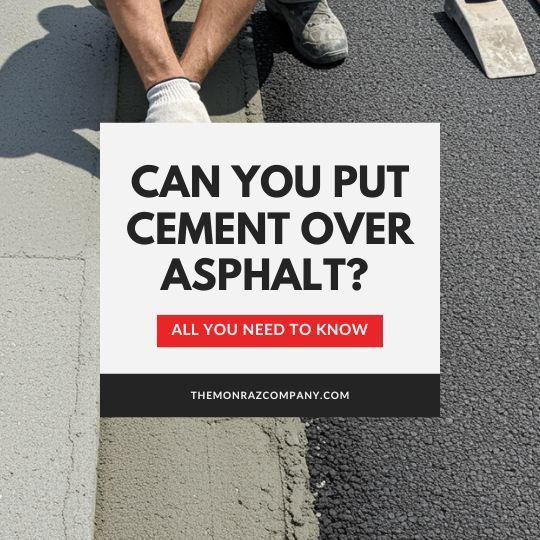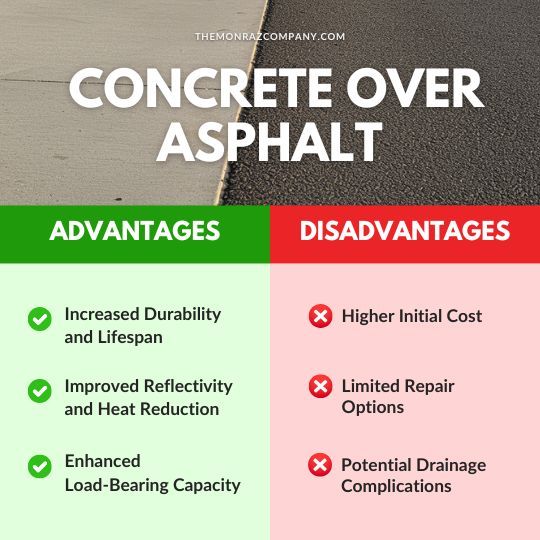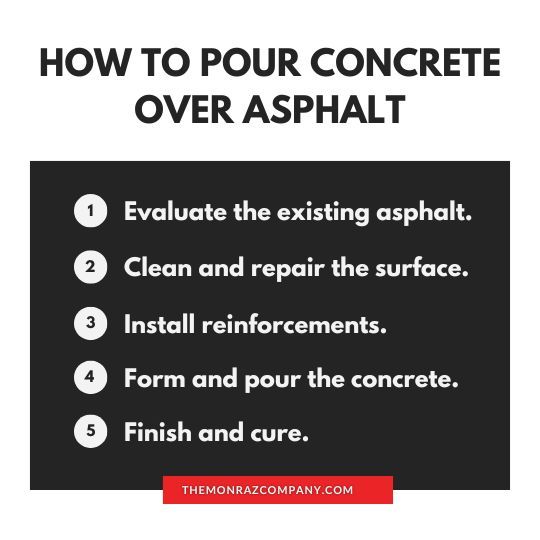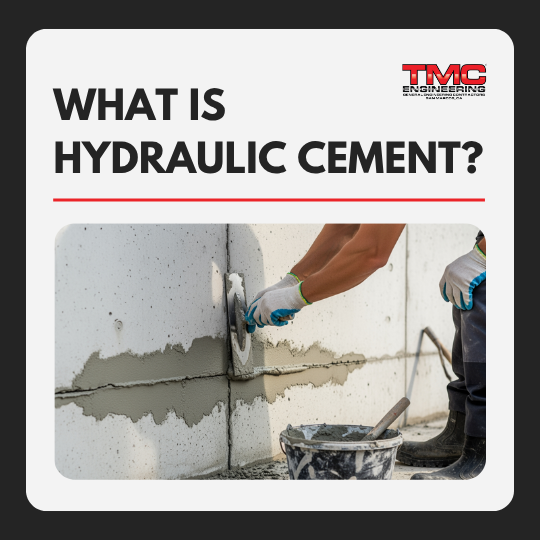Can You Put Cement Over Asphalt?: All You Need To Know
Spreading cement over asphalt can seem to be an unusual method at first glance. However, concrete poured over asphalt has become increasingly popular as a standard procedure in the construction business, particularly for commercial structures that are seeking low-cost renovation techniques. This technique offers unique advantages to property owners who wish to renovate existing surfaces without complete removal of the original material.
This article examines whether one can pour concrete over asphalt surfaces and examines the key factors commercial property owners should consider prior to undertaking these kinds of endeavors.
If you’d like a quicker or more specific answer to your asphalt or concrete repair questions, call the experts at TMC Engineering! If you’re in Southern California, we can help educate you on your problem and perform whatever repair is necessary. We’ve got an expert solution for your commercial concrete or asphalt concerns!

Can You Put Cement Over Asphalt?
Yes, concrete can be poured over existing asphalt surfaces under specific conditions. This process, known as "concrete overlay" or "whitetopping," involves applying a layer of concrete directly on top of an asphalt substrate. However, success depends entirely on proper preparation and execution.
When concrete meets asphalt, several important interactions occur. The asphalt serves as a semi-flexible base that supports the rigid concrete layer above. This combination creates a unique pavement system that combines the properties of both materials.
Commercial property managers should consider several factors before proceeding:
- Age and condition of the existing asphalt
- Expected traffic load on the finished surface
- Drainage requirements and existing patterns
- Climate conditions in the region
- Budget constraints and long-term maintenance plans
Parking lots with severely deteriorated asphalt may require remediation before overlay. Concrete bonds poorly adhere to crumbling, oil-saturated, or extensively cracked surfaces. Professional assessment helps determine whether your asphalt base can adequately support a concrete overlay without premature failure.
What Are The Advantages Of Concrete Over Asphalt?
Increased Durability and Lifespan
Concrete pavement surfaces last significantly longer than traditional asphalt road surfaces. When properly installed over stable asphalt, concrete overlays will last 20-30 years which is nearly twice as long as single-course asphalt surfaces. This increased service life translates into less replacement and lower lifetime ownership costs.
Commercial properties benefit from this strength in high-traffic areas where frequent repaving disrupts business. The initial expense of covering asphalt with concrete is well worth it through decades of hassle-free operation with minimal maintenance required.
Improved Reflectivity and Heat Reduction
Concrete's light color reflects significantly more solar radiation than dark asphalt surfaces. This reflective property reduces surface temperatures by up to 15°F compared to asphalt alone.
For commercial properties, this translates to measurable benefits such as:
- Reduced air conditioning costs for adjacent buildings
- Decreased contribution to urban heat island effect
- Improved comfort for pedestrians and customers
- Lower thermal stress on the pavement system itself
Shopping centers and retail establishments particularly benefit from cooler parking lots that enhance customer comfort during the summer months.
Enhanced Load-Bearing Capacity
The combination of asphalt and concrete offers a structural system with more load-carrying capacity than asphalt alone. Concrete overlays are therefore ideal for commercial applications with heavy traffic by vehicles or by stationary loads.
Distribution centers, manufacturing facilities, and commercial parking garages stand to benefit most from this added structural capacity. The concrete surface distributes vehicle loads more evenly while the underlying asphalt provides some flexibility that avoids cracking.

What Are The Disadvantages Of Concrete Over Asphalt?
Higher Initial Cost
Managers of commercial properties must carefully weigh the initial cost against long-term benefits. While concrete overlays prove to be cost-effective long term, organizations with immediate budget constraints may find the upfront cost challenging to justify to stakeholders.
Limited Repair Options
When concrete overlays develop problems, repairs prove more complex and costly than equivalent asphalt maintenance. Crack sealing, partial replacement, and surface treatments all require specialized techniques when applied to concrete-over-asphalt systems.
Facility managers should establish maintenance protocols specifically designed for these hybrid pavement systems. Standard concrete repair methods often require modification when the substrate consists of asphalt rather than traditional base materials.
Potential Drainage Complications
Setting down a concrete slab increases surface height, which can disrupt established drainage patterns. Height increase can cause ponding issues, affect accessibility compliance, or create unwanted transitions to adjacent surfaces.
Commercial building owners must carefully engineer drain solutions when pouring concrete over asphalt, particularly in expansive parking lots where proper water management becomes a deciding factor in functionality and regulatory compliance.

How To Pour Concrete Over Asphalt
Step 1: Evaluate the existing asphalt.
Begin by thoroughly assessing the condition of the existing asphalt surface. Professional evaluation identifies structural issues that might compromise the concrete overlay.
The ideal candidate for concrete overlay has:
- Minimal cracking
- Good structural integrity
- Proper drainage characteristics
- Limited oil or chemical contamination
Commercial properties should commission core samples to verify asphalt thickness and subgrade conditions. This critical evaluation determines whether the existing asphalt can support concrete overlay or requires remediation before proceeding.
Step 2: Clean and repair the surface.
Thoroughly clean the asphalt surface to remove all debris, vegetation, oil spots, and loose material. High-pressure washing effectively prepares the surface for concrete application.
After cleaning, complete necessary repairs including:
- Fill significant cracks with appropriate materials
- Address any drainage issues
- Remove severely damaged sections
- Create proper transitions at edges and joints
This preparation establishes the foundation for successful concrete bonding and determines the ultimate performance of the overlay system.
Step 3: Install reinforcements.
Strategic reinforcement significantly enhances concrete overlay performance. Depending on the application requirements, install either:
- Welded wire mesh
- Fiber reinforcement mixed into the concrete
- Rebar grids for heavily-loaded applications
Commercial applications typically benefit from professional-grade reinforcement systems that minimize cracking and extend service life. The reinforcement selection should align with expected traffic patterns and load requirements.
Step 4: Form and pour the concrete.
Install edge forms to control concrete thickness and create clean transitions. When pouring concrete over asphalt, maintain consistent thickness. It is typically 3-6 inches for commercial applications depending on expected loads.
Mix concrete to appropriate specifications for the application, typically achieving:
- 4000+ PSI compressive strength
- Air entrainment is appropriate for the climate
- Proper slump for workability
The pouring process requires careful coordination to ensure uniform coverage and proper consolidation. Commercial projects benefit from professional concrete placement equipment that ensures consistency across large areas.
Step 5: Finish and cure.
Proper finishing techniques create durable, functional surfaces:
- Bull float to establish initial flatness
- Edging along forms
- Appropriate texture for the intended use
- Joint creation at specified intervals
After finishing, implement appropriate curing protocols. Proper curing critically affects concrete strength development and long-term performance. Commercial properties should maintain optimal moisture conditions for at least 7 days after pouring the concrete.
If you’re in the San Diego area and need assistance with your concrete overlays, don’t hesitate to reach out to us atTMC Engineering. We have the experience and expertise to give quality and durable results to meet our every need.
Contact us today for a free estimate on an inspection and repairs for your commercial building. Your structure’s longevity and safety depend on it.
Yes, concrete can be poured over existing asphalt surfaces under specific conditions.
Concrete overlays on commercial properties represent a significant investment that delivers extended service life when properly executed. By following these established protocols, property managers can successfully upgrade asphalt surfaces to concrete, gaining durability and performance advantages while maximizing return on infrastructure investments.
For more information on how to deal with other issues on concrete, you can visit
our blog. We have plenty of guides on numerous concrete issues, such as
concreteparking lot repair,
how to remove tar from concrete, and so on.
At
TMC Engineering, we have a deep commitment to delivering projects characterized by the highest
standards for safety, workmanship, and client satisfaction. We aim to provide you with valuable content and insights related to the
services our
team of experts provides!
Whether you require
asphalt paving,
striping, or
concrete work, we offer a full suite of transportation construction solutions. Look no further—we’ve got all you need and more!




